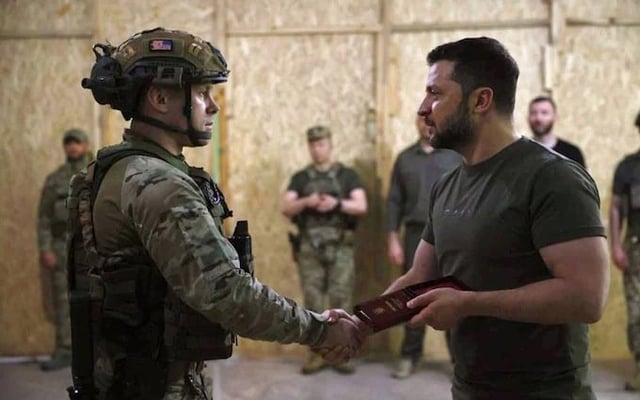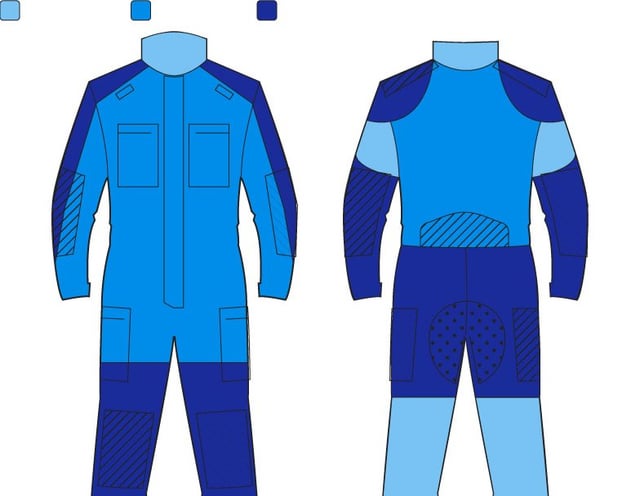

Unlike traditional body armor, which is built to stop bullets with ceramic plates, Shyriaiev’s design emphasizes flexibility and targeted protection. The overalls are not bulletproof, but that’s not their purpose. Instead, they’re engineered to shield soldiers from the most common injuries in today’s trench warfare wounds caused by shrapnel from grenade blasts, artillery, and aerial drone attacks. These types of injuries often strike exposed joints and limbs rather than the torso, which is usually already armored.
The suit uses layers of Kevlar and other energy-dispersing materials to protect critical areas like the knees, elbows, thighs, shins, and ankles, spots often exposed during movement or when soldiers are crawling or pinned down in static positions. Shyriaiev, who serves in the 109th separate territorial defense brigade, said the idea came directly from the battlefield. The need for such protection was obvious, and the traditional gear wasn’t meeting it.
This isn’t a replacement for existing armor or helmets but a vital supplement to them. By layering over standard-issue kit, the suit increases the total area of the body covered without adding significant weight or reducing mobility. It offers protection from high-velocity fragments while allowing soldiers to maneuver through trenches and urban ruins with ease.
Shyriaiev’s team is already working on the next evolution of the concept: blast-resistant insoles for military boots. Injuries to the feet and lower legs from mines and ground blasts are another persistent risk, and current footwear doesn’t do enough to guard against it. He believes that small but thoughtful enhancements to gear can significantly reduce long-term injuries among troops.
What makes this development stand out is that it didn’t come from a military contractor or a government office, it came from a soldier with firsthand knowledge of what’s needed on the ground. Shyriaiev made clear that the idea was his own initiative, developed because nothing like it previously existed in the Ukrainian arsenal.
At the same time, Shyriaiev remains firmly committed to the central role of infantry in modern warfare. Despite the rise of drones, artillery, and long-range strikes, he stresses that soldiers remain at the heart of every operation. Drones still require a human operator, a soldier must still decide when and where to strike, and war ultimately depends on those willing to move forward on foot.
This innovation is not a leap into a futuristic battlefield, it's a grounded, practical response to the very real, very current dangers Ukrainian troops face every day. Designed by someone who shares those dangers, the new combat suit is less a piece of technology and more a survival tool, one shaped by necessity, driven by experience, and built to save lives.
Source: Bricktop_NAFO
by GermanDronePilot
11 comments
innovation and human ingenunity is the future guys.
Makes sense. FPV operators often seem to aim for the ground next to their target. Presumably both to increase the likelihood of a detonation and presumably in the hole of hitting something important in the legs.
At this point in the war, less than 5% of casualties are from small arms.
75% are from drones, and 15% are from artillery.
Trading heavy ballistic plates for more coverage against shrapnel seems worthwhile.
Needs a large, thick codpiece to protect the family jewels.
This is not new technology. Congrats to him, but this is a nothingburger.
I wear a Motoport Kevlar motorcycle riding suit. The fabric is flexible and not too heavy. Have hit the pavement at high speeds and suffered zero abrasions when I otherwise would have lost a lot of skin. Not sure it would stop drone shrapnel but the fabric and manufacturing method certainly worth a look.
I wonder how long till we see a suit with Built-In Tourniquets.
So a frag suit?
Probably gonna sweat their balls off wearing it. But it certainly beats getting them blown off.
Showing again, that Ukraine dominates in innovation and advancements. Curious to see how they upgrade the footwear to make them blast resistant and keeping it affordable and practical.
getting hot just thinking about it
Comments are closed.